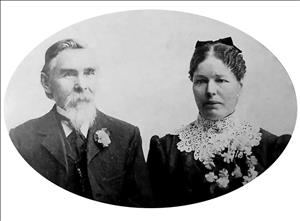Frank Stevenson and Mary Fell Stevenson were considered the father and mother of the city of Enumclaw, located midway between Seattle and Mount Rainier. The community had its beginning when, in 1885, the Northern Pacific Railroad accepted the Stevensons' gift of cleared, level land for a siding and routed its transcontinental railroad through their homestead. As the Stevensons anticipated, the city took root on their property. The community began in 1884 when the enterprising Stevensons filed a plat and built a two-story hotel facing the anticipated track. They gave away neighboring lots to John Blake and Arthur Griffin for a general store and to Mary’s father, Joseph Fell, for a saloon.
Homesteaders
The Stevensons had met and married in Iowa in 1874 and moved from there to California, and then, in 1879 to the site of future Enumclaw where they filed the claim for their homestead. Frank Stevenson was born in Cornwall, England, and had worked as a coal miner in Pennsylvania before migrating to Iowa. Mary was born in Ontario, Canada. She later recalled that their homestead in the shadow of Mount Rainier was “wild and woody land, full of mud, water and mosquitoes" (Poppleton). Frank cut a path through the dense forest and built a cabin, then cleared giant old-growth trees from 20 acres. Mary rode her horse along rough forest trails to the post office at Osceola and to the store about seven miles away in the coal mining community of Wilkeson. By the mid-1880s, the Stevensons were operating a farm and taking boarders into their substantial new home.
At first, the Stevensons operated the hotel themselves, charging $21.50 per month for room and board. Their guests included railroad bosses, new settlers, and timber speculators interested in buying railroad land. Once their business was established, they leased out the hotel. They moved into a new seven-room home built of locally milled lumber, the finest house in town.
In 1889, 1890, and 1991, the Stevensons platted new additions and sold lots for homes and businesses. As caring stewards of the community, they gave away building sites for the Catholic and Presbyterian Churches, a cemetery, and a public school. They also gave land to the White River Lumber Company for the mill that would become a major local employer. Because of their generosity and civic-mindedness, the Stevensons gained popular recognition as the “Mother and Father of Enumclaw.” Mary took an interest in all aspects of the town, and Frank was described as “honest, sincere, public-spirited, and highly regarded by all who knew him" (Bagley).
Frank remained active in the community through its incorporation as a city in 1913. He died the next year, on August 27, 1914. Two years later, Mary married Whitfield Yerxa, who platted the Yerxa addition and constructed the city’s first apartment buildings. When Mary died on November 11, 1928, she bequeathed the old house that she and Frank had shared to the town for a public library.
Ten years later, C. B. Lafromboise, editor of the Courier-Herald, paid tribute to the Stevensons on the city’s 50th anniversary: “If they could but return for a day to marvel at the community they helped to be wrought out of the wilderness, their joy would probably be supreme. As they endured and strove to create a new home in the wilderness, so should we dedicate ourselves to make the most of the heritage they left behind.”

